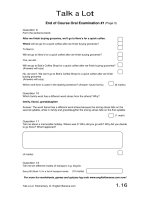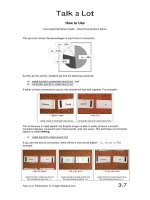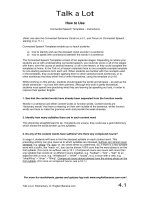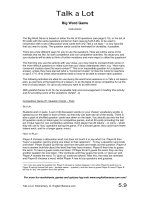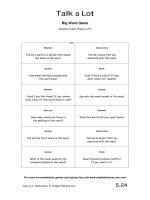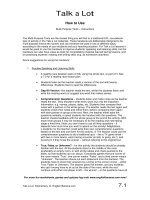Tài liệu Spoken english elementary handbook part 5 ppt
Bạn đang xem bản rút gọn của tài liệu. Xem và tải ngay bản đầy đủ của tài liệu tại đây (917.41 KB, 15 trang )
Talk a Lot
How to Use
Connected Sentence Cards – Sound Connections Demo
Talk a Lot Elementary © English Banana.com
3.7
This pie chart shows the percentages of each kind of connection:
cv – 10%
vv – 12%
As they do the activity, students will find the following outcomes:
a) vowel sound to consonant sound (vc)
and
b) consonant sound to vowel sound (cv)
If either of these connections occurs, the sounds will flow well together. For example:
LDÇwflåKáDÇÉéL=
vowel sound to consonant sound (vc)
LDïflípK]L=
consonant sound to vowel sound (cv)
This is because in rapid speech the English tongue is able to easily produce a smooth
transition between consonant and vowel sounds, and vice versa. This technique of connected
speech is called linking.
c) vowel sound to vowel sound (vv)
If you see this kind of connection, there will be a new sound added – LàL, LïL, or LêL. For
example:
LDÇÉfKòáKà]åÇL=
=
vowel sound to vowel sound (vv)
=
the connecting sound is LàL
LDäáWKà]rKïfòL=
=
vowel sound to vowel sound (vv)
the connecting sound is LïL
LDëfKå]Kã]KêflåL=
=
vowel sound to vowel sound (vv)
the connecting sound is LêL
vc – 30%
cc
– 48%
Talk a Lot
How to Use
Connected Sentence Cards – Sound Connections Demo
Talk a Lot Elementary © English Banana.com
3.8
This is because in rapid speech the English tongue can’t cope with two vowels flowing
together, so we have to introduce a consonant sound between them, making the connection
just like either (vc) or (cv) (see above). This technique of connected speech, where we add a
new sound, is called intrusion.
a) consonant sound to consonant sound (cc)
If you see this kind of connection, you should stop and think about how the sounds go
together. It’s very common in rapid speech for consonant sounds not to flow well together.
Say the words on the cards together and listen to the connecting sounds. It’s likely that a
sound will be missing at the end of the first word, especially if that sound is LíL, or LÇL. This
technique of connected speech, where a sound disappears, is called elision. For example:
LDãìëDêÉåíL=
=
LíL at the end of the first word
disappears to make the transition
between the two words easier to say
(elision)
LÇ~råDä]rKÇ]DÑfÑKíáWåL=
=
LÇL at the end of the first word
disappears to make the transition
between the two words easier to say
(elision)
In addition to this, the sound that disappears may be replaced by a glottal stop, which is a
very short pause. Or the sound at the end of the first word may change to make the next
sound – at the beginning of the next word – easier to say, for example LÏL at the end of “-ing”
words often changes to LåL. In other words, we “drop” the “g”. This technique of connected
speech, where a sound changes, is called assimilation.
LDä]rDľ\KÇwf\DÜflKê]L=
=
LíL at the end of the first word is
replaced by a glottal stop L\L to make
the transition between the two words
easier to say (glottal stops)=
LDê~fKífåKa]L=
=
LÏL at the end of the first word
changes to LåL to make the transition
between the two words easier to say
(assimilation)
LflãDîôKä]åKí~fåòL=
=
LåL at the end of the first word
changes to LãL to make the transition
between the two words easier to say
(assimilation)
If two of the same consonant sounds meet, the first sound will become redundant and
disappear, for example:
Talk a Lot
How to Use
Connected Sentence Cards – Sound Connections Demo
Talk a Lot Elementary © English Banana.com
3.9
Lê]rDãôåKífDâflKã]KÇáL=
=
LâL meets LâL so the first sound
disa
ppears (elision)
LDâäôKëfDâflKã]KÇáWòL
=
LâL meets LâL so the first sound
disa
ppears (elision)
LDÑêÉåDëlWL=
=
LëL meets LëL so the first sound
(along with LÇL) disappears (elision)
Sometimes, however, the consonant-consonant (cc) sounds will flow together well. Students
will see this very clearly if the consonant sound at the end of the first word is LëL or LòL (see
examples below). Why does this happen? Because after making these sounds, your mouth
and tongue are in a fairly neutral position and ready to make any sound. Try saying LëL and
LòL separately now. Where is your tongue? Where are you lips? In what position does your
mouth end up after saying each sound? Now try saying the words below together. Compare
this to saying LíL, or any word with LíL at the end. After saying LíL your tongue is right behind
your teeth, fully committed to the sound, and in a bad starting position to make the next
sound.
LfíëDâìWäL=
=
LëL meets LâL and they flow together
smoothly (linking)
LDîôKä]åKí~fåòDÇÉfL=
=
LòL meets LÇL and they flow together
smoothly (linking)
LDÇ]råDä~fâL=
=
LíL meets LäL and they don’t flow
together smoothly, so LíL is
automatically omitted by the speaker
(elision)=
Having said all of this, sometimes there will be no connection between the two sounds
because of the natural break, or pause, provided by a punctuation mark, such as a dash – ,
semi-colon ; , or comma , , for example:
LDÄflâKëÉíKàìWäL=
=
here two consonant sounds meet – LíL=and LàL – but
there is a natural break in the speech provided by the
comma, so LíL remains and elision doesn’t happen
3
3
!
Talk a Lot
How to Use
Connected Sentence Cards – Sound Connections Demo
Talk a Lot Elementary © English Banana.com
3.10
Students should try using the connected sentence cards to explore the different sound
connections between pairs of words, and how connected speech techniques come into play
each time. They could also try this method with any sentence – one that they have written
themselves, or one from a newspaper, book, or magazine, using the template below to help
them. The outcomes will be generally the same as those shown above.
------------------------------------------------------------------------------------------------------------------------
Connecting Sounds (Activity Template)
1. Choose (or write) a sentence: _________________________________________
2. Count the no. of words in the sentence: ______
3. Count the no. of connections between words in the sentence: ______
4. Count each kind of connection between words, and write down
the connecting sounds for (vv) and (cc) connections, using the IPA:
# vowel-consonant (vc)
OK
3
# consonant-vowel (cv)
OK
3
(No elision, intrusion, assimilation, etc. needs to
take place, because the words flow together well)
# vowel-vowel (vv)
Possible techniques of connected
speech:
•
intrusion
# consonant-consonant (cc)
•
elision
•
glottal stops
•
assimilation
Total:
------------------------------------------------------------------------------------------------------------------------
Let’s look at a complete sentence from Unit 2 of Talk a Lot Elementary Book 3, on the topic of
“Films” (from which all of the examples in this demo also come):
LDÇÉfKòáKà]åK]DÄlfKÑêÉåÇK]KÖ]rKïfåKí]DïflípK]
ê]rDãôåKífDâflKã]KÇáKà]\Ka]DëfKå]Kã]KêflãDîôKä]åKí~fåòDÇÉfL=
Talk a Lot
How to Use
Connected Sentence Cards – Sound Connections Demo
Talk a Lot Elementary © English Banana.com
3.11
Here is a completed activity template as an example:
Connecting Sounds (Activity Template)
1. Choose (or write) a sentence: _____________(see above)___________________
2. Count the no. of words in the sentence: __17__
3. Count the no. of connections between words in the sentence: __16__
4. Count each kind of connection between words, and write down
the connecting sounds for (vv) and (cc) connections, using the IPA:
# vowel-consonant (vc)
5
OK
3
# consonant-vowel (cv)
2
OK
3
(No elision, intrusion, assimilation, etc. needs to
take place, because the words flow together well)
# vowel-vowel (vv)
Possible techniques of connected
speech:
•
intrusion
3
“Daisy and” – LáL to L]L – connecting sound: LàL
“comedy at” – LáL to L]L – connecting sound: LàL
“cinema on” – L]L to LflL – connecting sound: LêL
# consonant-consonant (cc)
•
elision
•
glottal stops
•
assimilation
6
16
“and her” – LÇL to LÜL – LÇL and LÜL both
disappear (elision)
“going to” – LÏL to LíL – LÏL changes to LåL
(assimilation)
“romantic comedy” – LâL to LâL – same sounds:
the first LâL disappears (elision)
“at the” – LíL to LaL – LíL disappears (elision)
“on Valentine’s” – LåL to LîL – LåL changes to
LãL (assimilation)
“Valentine’s Day” – LòL to LÇL – LòL enables a
smooth transition (no elision, etc. takes place)
Another helpful technique is to study and learn connections that occur often, in phrases that
are common in spoken English – and particularly in phrases that comprise unstressed
function words. For example:
L]\Ka]L=
=
LíL at the end of the first word disappears to make the
transition between the two words easier to say
(elision), and is replaced by a glottal stop.
LÖ]rKïfåKí]L=
=
when used as a future form, these three syllables are said
quickly because they are unstressed function words. LÏL at
the end of the first word changes to LåL to make the
transition between the two words easier to say
(assimilation). Often this very common phrase is shortened
even further to “gunna”: LÖ¾åK]L. This enables the speaker to
get even more quickly to the point of what they’re trying to
say, i.e. the active verb: “I’m gunna buy...” etc.
Total:
Talk a Lot
How to Use
Connected Sentence Cards – Sound Connections Demo
Talk a Lot Elementary © English Banana.com
3.12
Once students have understood sound connections between words, and how the techniques
of connected speech are employed, they should combine this knowledge with work that they
have done on sentence stress (see from page 12.1) to form natural-sounding English speech,
for example:
LDÇÉfKòáKà]åK]DÄlfKÑêÉåÇK]KÖ]rKïfåKí]DïflípK]
ê]rDãôåKífDâflKã]KÇáKà]\Ka]DëfKå]Kã]KêflãDîôKä]åKí~fåòDÇÉfL=
In this picture we have visualised the complete sentence, with all of the sound connections between the words
highlighted by the black and white bars. You can also see the sentence stress, with the content words (Daisy,
boyfriend, watch, romantic, comedy, cinema, Valentine’s, and Day) raised above the function words (and, her, are,
going, to, a, at, the, on). Students could also identify the stressed syllable with its accompanying vowel sound in each of
the content words, and write them on the cards (as we have indicated above). Students should practise saying the
sentence out loud again and again, whilst focusing on three things:
1. The stressed syllables
2. The vowel sounds on the stressed syllables
3. The different connections between the words
Students could also spend time working with the connected speech templates (see page 4.1),
which pull together all of this work into one activity.
=
Towards the end of this activity, students could try putting together cards that make different
sound combinations, to test the outcomes demonstrated above. They shouldn’t worry about
the resultant phrases making sense, but instead focus entirely on how the sounds go together
(see examples below). A good extension would be for students to write and practise saying
two-word phrases that do make sense, and which highlight each of the following categories:
• (vv) – connected with LàL e.g. “high ice”
• (vv) – connected with LïL e.g. “through everything”
• (vv) – connected with LêL e.g. “here anyway”
• (cc) – where LíL at the end disappears (elision) e.g. “hit back”
• (cc) – where LÇL at the end disappears (elision) e.g. “red car”
• (cc) – where LëL or LòL at the end enables a smooth transition e.g. “wise guy”
• (cc) – where the same sounds meet and the first is cancelled out e.g. “in need” [etc.]


